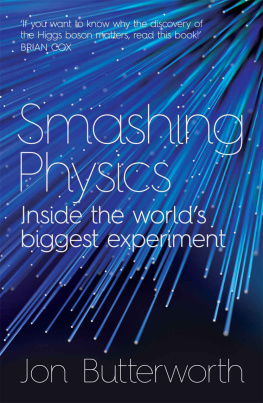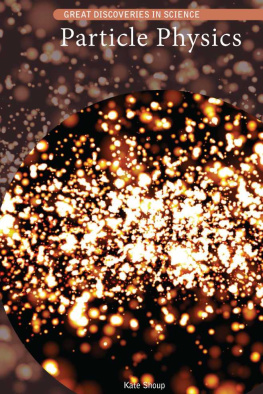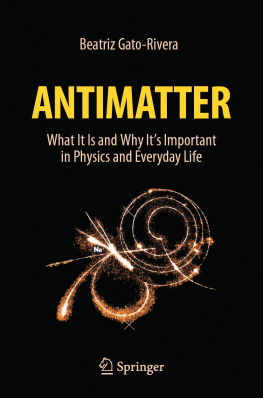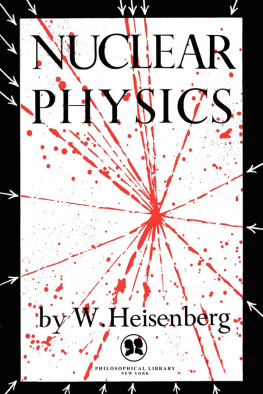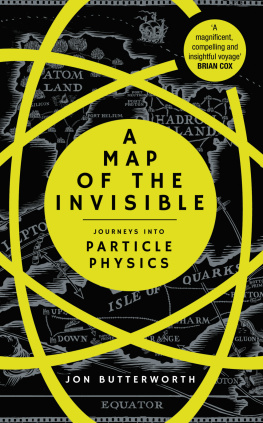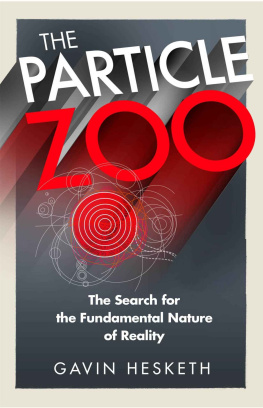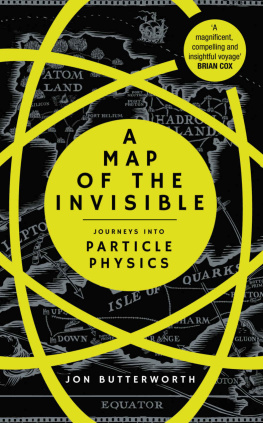About the Author
JON BUTTERWORTH is a professor in the Department of Physics and Astronomy at University College London and a member of the ATLAS collaboration at CERNs Large Hadron Collider in Geneva, Switzerland. He writes the Life and Physics blog for the Guardian, has written articles for a range of publications including the BBC and New Scientist, and is also the author of Most Wanted Particle, shortlisted for Book of the Year by Physics World. He was awarded the Chadwick Medal of the Institute of Physics in 2013 for his pioneering experimental and phenomenological work in high-energy particle physics. For the last fifteen years, he has divided his time between London and Geneva.
. I think there is such a quiet spot in my office at CERN, the European Organization for Nuclear Research, which is why, in the birthplace of the World Wide Web, I still struggle to get on the Internet sometimes. There are just too many waves arriving at the wrong times and happening to cancel each other out in the vicinity of my desk.
. I apologize to the seagull. That got unexpectedly violent.
. This difference spurred the development of quantum mechanics, and inspired a breakthrough from Albert Einstein that resuscitated the idea of light as a particle.
. Annalen der Physik 17 (1905) pp. 13248. See http://einsteinpapers
.press.princeton.edu.
. This is why on some physics wall charts, heavy particles are shown as big blobs compared to smaller blobs for lighter particles such as the electron.
. QED: The Strange Theory of Light and Matter, 1985.
. This is the same effect as minimum height of the land in a valley. On the sides of a valley, adjacent positions have different heights due to the slope, but at the base of the valleythe minimum heightthe ground is almost flat and adjacent points have almost the same height. In the same way, paths near the minimum number of turns have a very similar number of turns to each other, so they add up.
. It is.
. It is tempting to think that these must have been a welcome break from studying the English weather.
. The magnetic force on a particle depends on both its charge and its speed, whereas the electric force depends only on its charge. So when these are made to be equal, with a bit of algebra the unknown charge can be canceled out and the speed can be calculated.
. Knowing the speed is crucial, because that tells you how long the electric force acts on the electrons as the beam passes between the plates. The impulse from the force deflects the beam by an amount depending on the charge (high charge means a larger force, so a larger deflection) and the inverse of the mass (high mass means more inertia, so smaller deflection). The result is that the deflection depends on the ratio of the charge and the mass.
. This is a very painstaking experiment, even more so when carried out with oil drops instead of standard spheres, as it was originally in 1910 by the American physicist Robert Millikan. The experiment is still carried out, largely without success, in far too many undergraduate physics laboratories by squinting and impatient students.
. The other common forms are beta particles, which are electrons, and gamma rays, which are photons.
. Apparently theres a good historical raisin for this.
. The equation that describes these waves is the Schrdinger equation. Less famous than his cat, but much more useful.
. This unfriendly behavior is the exclusion principle discovered by Wolfgang Pauli, one of the first explorers of our landscape, who we will meet again before too long.
. One electron volt (eV) is the energy of motion that an electron acquires if it is accelerated through one volt of electric potential. So a 12-volt battery can accelerate an electron to an energy of 12 eV. To get to millions of eV would require several hundred thousand such batteries. Or the nuclear power of one decaying nucleus.
. Recall that it was by balancing these two forces that J. J. Thomson discovered the electron.
. The original manuscript was submitted in 1864, but, in a situation familiar to scientists everywhere, it was then held up in peer review. Theres a letter, dated March 1865, from William Thomson (later Lord Kelvin) saying he was sorry for being slow, that hed read most of it and it seemed pretty good (decidedly suitable for publication).
. This is the way they appear at the foot of the statue of Maxwell near the Royal Society of Edinburgh.
. This is actually why they save on inkwhen we clump the components together into vectors and write the equations that way, the absolute directions of the vectors dont even appear in the equations. The physics does not depend on them.
. Energy is equal to the square of the momentum divided by twice the mass, E = p2/(2m), which is equivalent to the possibly more familiar expression for kinetic energy E = mv 2, where v is the velocity.
. If you want to know, the full expression is E2 = m2c4 + p2c4, where E is the energy, m is the mass, and p is the momentum. For zero momentum, this reduces to E2 = m2c4, and taking the square root of both sides gets us the familiar E = mc2. And possibly E = mc2, too (see text).
. This is true in Schrdingers equation. But because of the way relativity mixes up energy and momentum (and space and time), the momentum must appear to the same power as the energy. In the Schrdinger equation, the momentum appears squared, which wont do.
. You dont need to understand exactly how this works in order to continue our exploration, but if youd like to see it, here goes. We want an equation like E = Am + Bp, but is also consistent with E 2 = m2c4 + p2c4. If we square the first equation we have to multiply all the terms by each other, so we get E 2 = A2m2 + (AmBp) + (BpAm) + B2p2. Now we have two expressions that ought to both equal E 2, so they must equal each other: m2c4 + p2c4 must equal A2m2 + (AmBp) + (BpAm) + B2p2, for any values of m and p. If we let A2 and B2 both be equal to c2, that takes care of the terms involving the square of the mass and the square of the energy. But we are left with the other bit (AmBp) + (BpAm). This can only be zero (for all values of p and m, because we want an equation that works for all particles) if AB is equal to the negative of BA. But for all numbers, AB equals BA. So A and B cannot be numbers.
. From the point of view of mathematics, the numbers can be pretty much anything you like, although if we want to use them to help us understand physics, they take on specific meaning. For example, the numbers in a matrix can encode how the different components of a magnetic field change when we rotate it through some angle around some direction.
. Most days except Monday, in fact.
. Though, disappointingly, not in their personal lives.
. Newtons law, F = ma.
. An innovation due to Michael Faradays very early thoughts about electricity and magnetism.
. Or to put it another way, they can smash it up.
. A translation of the original Das Weltbild der neuen Physik


